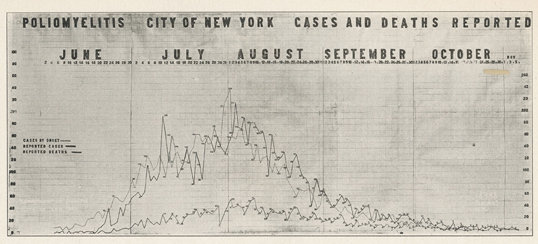6. Polio
 Chart by the Department of Health of New York City, 1916. Photo from Wikimedia Commons.
Chart by the Department of Health of New York City, 1916. Photo from Wikimedia Commons.
The 1916 New York City polio epidemic infected several thousand people while killing over two thousand, primarily in Brooklyn. Polio, On July 17, 1916, Brooklyn officially announced the existence of a polio epidemic after a handful of people tested positive at a Brooklyn clinic. In June, there were over 100 cases of infantile paralysis in Brooklyn, which continued to grow across the city until the end of the year. The disease remained prevalent in the U.S. until the development of Jonas Salk’s polio vaccine in 1954.
During the height of the epidemic, movie theaters and other public places were closed, public gatherings were mostly canceled, and children were discouraged from going to swimming pools or beaches. The houses of infected patients were marked with placards and families were quarantined. Simon R. Blatteis of the Bureau of Preventable Diseases organized a special staff of medical inspectors and nurses to visit all cases daily, and by July 1916, Blatteis had established six clinics in Brooklyn to receive polio victims.





